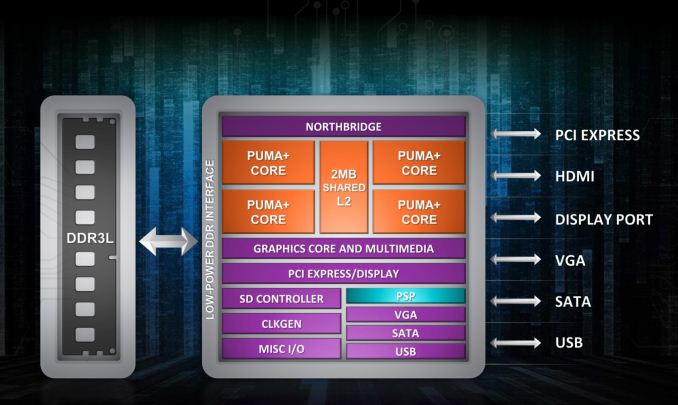AMD Beema/Mullins Architecture & Performance Preview
by Anand Lal Shimpi on April 29, 2014 12:00 AM ESTFinal Words
Despite no significant changes to the architecture or manufacturing process, AMD’s 2014 updates to its entry level and low power silicon are substantial. We finally have AMD silicon, built around a non-Bulldozer architecture, that seem to have turbo capabilities comparable to Intel’s. The result is a completely different performance profile. While AMD’s Jaguar cores in Kabini and Temash were easily outperformed by Intel’s Bay Trail, Puma+ pulls ahead. AMD continues to hold a substantial GPU performance advantage as well.
The gains in performance come while decreasing platform power. You can now have roughly the same performance as AMD offered last year in a 15W entry level notebook part, in a 4.5W TDP (2.8W SDP) tablet SKU. That’s seriously impressive.
The progress AMD made in a year with Beema and Mullins shows just how time constrained the team(s) were with bringing Kabini and Temash to market in 2013. While both of those SoCs were quite successful for AMD, I expect that at some point AMD won’t be allowed two years to fully polish a single design.
The big unknown is how these new SoCs stack up against Bay Trail when it comes to power consumption. From a performance standpoint at the very high end they are faster, but we’ll have to wait until we can get our hands on shipping devices before we know the full story when it comes to battery life. AMD expects to see Beema and Mullins designs show up over the next 1 - 2 quarters, with some designs shipping in the coming weeks to specific regions.
The other thing we need to see is a real Android strategy from AMD. Mullins seems like a good fit for a high performance Android tablet, but today AMD’s native OS strategy is exclusively Windows. I don’t think it’ll stay that way for long, but AMD has yet to give us any indication of when it’ll change.
And if I’m asking for things I want to see from AMD, you can add a PoP package and idle power that’s competitive with the likes of Apple and Qualcomm. AMD clearly came a long way over the past couple of years, but there’s still more progress to be made.











82 Comments
View All Comments
superunknown98 - Tuesday, April 29, 2014 - link
Although I don't think it would happen, or at least be publicly announced, Microsoft could use these new cores in Xbox One but could only enable turbo for the two cores that run the virtualization and Xbox OS. They would also benefit from the reduced TDP, which is something that eventually happens at some point anyway.lmcd - Thursday, May 1, 2014 - link
Now that comment on the OS and virtualization cores was quite interesting. I now thing that a Puma-edition is likely (though I think a GPU switch-up is more likely if more efficient GCN variants occur.MikeMurphy - Monday, May 26, 2014 - link
No sense revising an entire chip to save a few watts of power. They might revise it later provided that substantial power savings are attainable, otherwise will implement the usual die shrinks. Minor performance increases shouldn't be ruled out although focus will be on power reduction while maintaining similar performance.Rockmandash12 - Tuesday, April 29, 2014 - link
And this is what happens when AMD gets into gear and makes a new architecture. Real improvement that's competitive with rivals. Common.... new Desktop flagship architecture that's faster and more efficient? please?Samus - Wednesday, April 30, 2014 - link
This is pretty impressive. And honestly, out of nowhere. They all the sudden have an amazing tablet/uSFF SoC.silverblue - Tuesday, April 29, 2014 - link
Didn't Kaveri launch with a fully enabled PSP as well?Judging by the performance story thus far, I think it will put to bed the calls for cat cores to replace AMD's higher powered offerings. Yes, we're past K8 performance levels now, but Llano and Trinity (let alone Richland/Kaveri) still have it beat. You'd need some serious clock speeds to get decent performance and it's the wrong silicon for that.
I was disappointed to see that it's practically the same uarch as Jaguar, meaning we're still going to have a single channel memory controller, however the performance and power improvements are substantial, and the memory controller has been improved anyway which should reduce the need for said controller.
ET - Tuesday, April 29, 2014 - link
I think it's hard to draw conclusions of core performance when the RAM is a limitation. It's entirely possible that these cores are still pretty far from the big cores, but on the other hand it's possible that more bandwidth could up performance by quite a few percent.ssnitrousoxide - Tuesday, April 29, 2014 - link
AMD has always done some impressive work to squeeze every bit of performance from an inferior node. How they managed to improve energy efficiency so much is beyond me.mfoley93 - Wednesday, April 30, 2014 - link
It seems that most of the power reduction is at the manufacturing level; maybe it's more accurate to engineering tolerances or perhaps a more pure silicon, either way I don't think TSMC will be telling us what it is. The rest comes from eliminating circuitry that provides some more flexibility to OEMs, something nVIDIA has been doing for a couple years now, and while it doesn't reallycount, it's something Apple does very well.
yannigr - Tuesday, April 29, 2014 - link
Any idea if Beema will be compatible with existing AM1 motherboards?(with only a BIOS update of course)